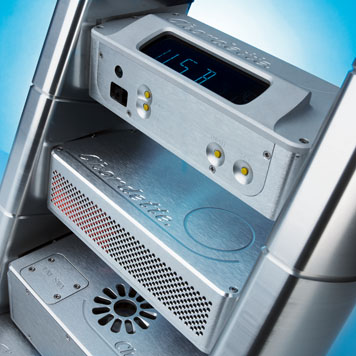What Hi-Fi? Verdict
Up the best full-size preamps available at this money. A top-class product
Pros
- +
Sonic transparency and agility
- +
compact
- +
dinky looks
- +
lovely build
- +
USB connectivity
Cons
- -
Buttons and connections lack proper labelling
Why you can trust What Hi-Fi?
Chord’s Chordette series is as bewildering a range of products as we have ever come across.
At the time of writing it’s nine-strong, and includes everything from a media centre PC to a phono stage, all built into a tiny cases barely bigger than a pair of playing cards packets stacked.
Unlike most rivals, Chord has happily acknowledged that future hi-fi systems are likely to be computer based.
Even so, the company has gone far further in accommodating such sources than many would have been expected.
Every one of the Chordette products has USB connectivity and on-board number crunching conversion circuitry – even the phono stage, though this goes the analogue-to-digital route to enable archiving onto a Mac or PC.
For this review, we’ve chosen to concentrate on the core products: the Prime preamp and Scamp power amp. Yes, you’re right; the names don’t make much sense…
For hardcore audiophiles the Prime preamp and matching Scamp power amp might be hard to take seriously, and their toy-like appearance really doesn’t help.
But treat them with the care you would afford any £2500 combo and we have no doubt they will impress.
Low power, but high quality
Let’s get the sonic negatives out of the way first. The Scamp power amplifier delivers just 20W per channel.
That’s not a lot, and means that high volume levels are off the menu unless you use very high sensitivity speakers (say 90dB/W/m and above) or have a small room.
However, stay below party levels and the Scamp proves a talented unit.
It comes equipped with a volume control, and so can be used without a preamp, though the limited inputs (just two) will restrict its use to very simple systems – a laptop connected via USB and an analogue source through the line level input, for example.
Anything more complex and you’ll need the Prime. This preamp is pretty much Chord’s mid-sized Prima in a smaller case, and without balanced circuitry.
You get four line-level inputs, USB and optical connections and full remote control. It’s a neat package.
In use, this pairing is wonderfully clear sounding, delivering high levels of detail and lightning response.
Impressively dynamic pairing
Listen to CDs of Chopin’s Funeral March, Holst’s Mars or even Kanye West’s Monster and this duo delivers a suitably enjoyable and energetic sound.
Within the power amp’s output limits, this is an impressively dynamic pairing that delivers really pleasing subtlety and power.
The tonal balance is a touch lean in Chord’s usual fashion, but it still sounds good enough to convince. The combo’s transparency level is top-class, and its ability to define the leading edge of notes is equally so.
Switch to USB, and it’s clear that the on-board DACs in the pre- and power amps are good, no surprise considering the quality of Chord’s excellent Gem.
Use the Mogul or any other computer as source and you’ll hear all the good things we’ve been describing, provided the files are of a good standard. Uncompressed recordings work best.
A few minor gripes
Moving away from sound quality we have a few complaints. The metal finishes on the units don’t match well: they vary in grain a little on our early production samples.
Cosmetically, the logos would look better if they all lined up properly, and we wish the front of the Mogul and Prime didn’t sprout unsightly inputs. We’d like a classier remote handset, too – the system deserves it.
It’s also a little surprising that Chord doesn’t supply the Scamp with a power supply. That costs an £150 extra, and without it the product doesn’t work. None of this stops us from admiring this system, though.
It proves that high-end sound doesn’t need a system that dominates the room, and it doesn’t need to look ugly.
This really is a case of having a high-end cake and eating it all.
Tested with
Chord Chordette Mogul media centre PC
Chord Chordette Scamp power amp
What Hi-Fi?, founded in 1976, is the world's leading independent guide to buying and owning hi-fi and home entertainment products. Our comprehensive tests help you buy the very best for your money, with our advice sections giving you step-by-step information on how to get even more from your music and movies. Everything is tested by our dedicated team of in-house reviewers in our custom-built test rooms in London, Reading and Bath. Our coveted five-star rating and Awards are recognised all over the world as the ultimate seal of approval, so you can buy with absolute confidence.


